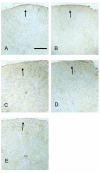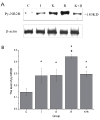Tyrosine phosphorylation of the N-Methyl-D-Aspartate receptor 2B subunit in spinal cord contributes to remifentanil-induced postoperative hyperalgesia: the preventive effect of ketamine
- PMID: 20042082
- PMCID: PMC2809057
- DOI: 10.1186/1744-8069-5-76
Tyrosine phosphorylation of the N-Methyl-D-Aspartate receptor 2B subunit in spinal cord contributes to remifentanil-induced postoperative hyperalgesia: the preventive effect of ketamine
Abstract
Background: Experimental and clinical studies showed that intraoperative infusion of remifentanil has been associated with postoperative hyperalgesia. Previous reports suggested that spinal N-methyl-D-aspartate (NMDA) receptors may contribute to the development and maintenance of opioid-induced hyperalgesia. In the present study, we used a rat model of postoperative pain to investigate the role of tyrosine phosphorylation of NMDA receptor 2B (NR2B) subunit in spinal cord in the postoperative hyperalgesia induced by remifentanil and the intervention of pretreatment with ketamine.
Results: Intraoperative infusion of remifentanil (0.04 mg/kg, subcutaneous) significantly enhanced mechanical allodynia and thermal hyperalgesia induced by the plantar incision during the postoperative period (each lasting between 2 h and 48 h), which was attenuated by pretreatment with ketamine (10 mg/kg, subcutaneous). Correlated with the pain behavior changes, immunocytochemical and western blotting experiments in our study revealed that there was a marked increase in NR2B phosphorylation at Tyr1472 in the superficial dorsal horn after intraoperative infusion of remifentanil, which was attenuated by pretreatment with ketamine.
Conclusions: This study provides direct evidence that tyrosine phosphorylation of the NR2B at Tyr1472 in spinal dosal horn contributes to postoperative hyperalgesia induced by remifentanil and supports the potential therapeutic value of ketamine for improving postoperative hyperalgesia induced by remifentanil.
Figures





References
Publication types
MeSH terms
Substances
LinkOut - more resources
Full Text Sources
Molecular Biology Databases

